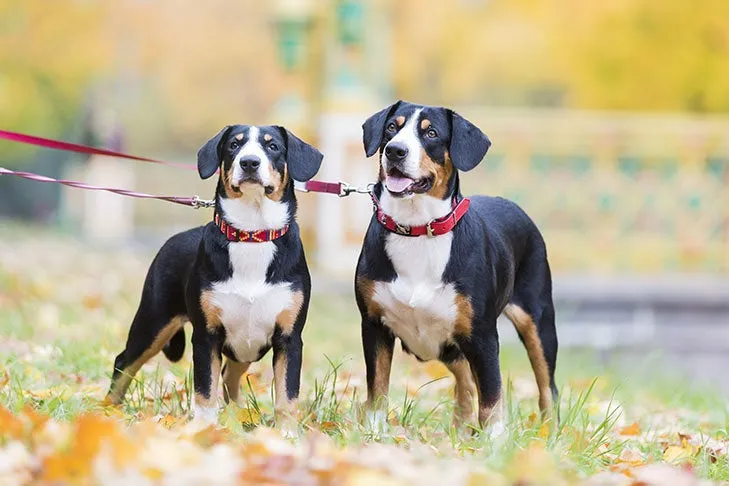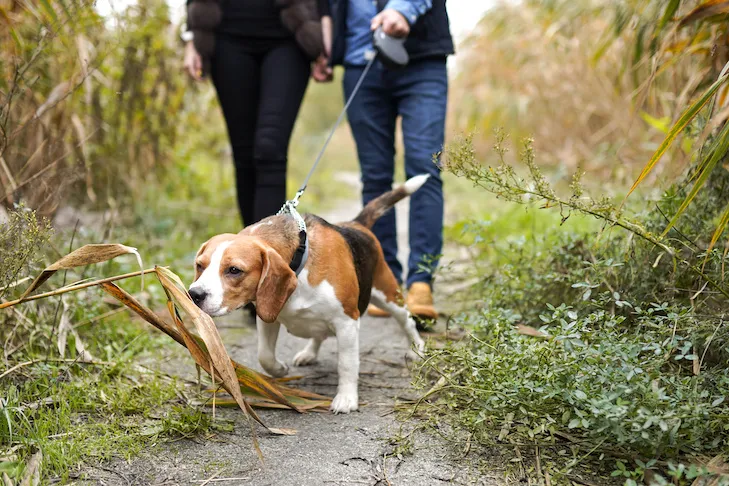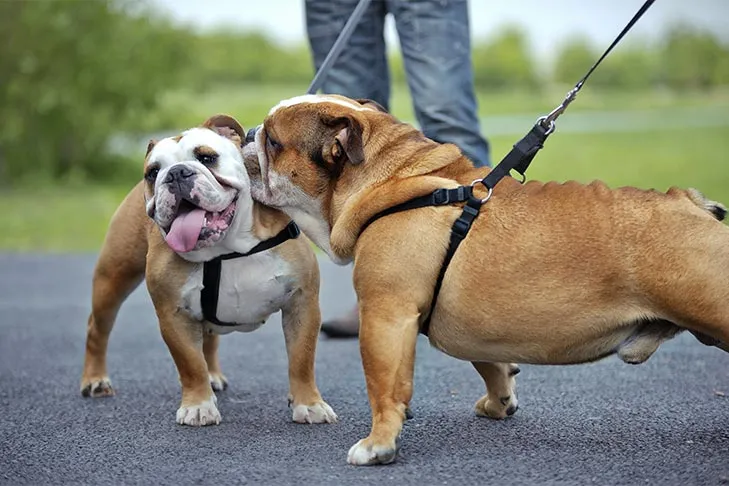Walking two dogs simultaneously can often feel like a juggling act. For owners of large dogs, this challenge is amplified by their sheer strength, leading to tangled leashes, two handles to manage, and the sensation of being pulled in multiple directions. If you’re struggling to maintain control and enjoyment on walks with your powerful companions, a specialized Double Leash For Large Dogs could be the effective answer you’ve been seeking.
While foundational leash training for polite walking remains paramount, under the right circumstances, a high-quality double dog leash designed for bigger breeds can significantly simplify the experience. This article will explore the specifics of double leashes, particularly their application for large dogs, and help you determine if this tool is the right fit for your canine duo. Finding the right gear can transform your walking experience, much like discovering the best online shopping for dogs for all your pet needs.
What Is a Double Dog Leash (and Why Consider One for Big Breeds)?
Double dog leashes, often referred to as couplers or leash splitters, are innovative devices that enable you to walk two dogs with just one handle. The leash typically splits into two sections near the dogs, providing each with their own lead while you maintain singular control. This design inherently reduces the common frustrations of tangled leashes and managing multiple handles, making walks more manageable, especially when dealing with the combined power of two large dogs.
The market offers a diverse range of double leashes, featuring various options to enhance functionality and safety. For large dog owners, specific features become particularly important. Look for heavy-duty double leashes constructed from durable materials that can withstand significant pulling force. Swiveling connectors are crucial as they prevent tangles even when your large dogs cross paths or change directions, ensuring a smoother walk. Bungee cord ends are another valuable addition, designed to absorb shock and minimize strain on your arm if your large dogs suddenly pull, providing a more comfortable experience for both handler and pet. Some models also allow for adjustable length on each side, which is beneficial if your large dogs are of different heights or have slightly varied walking styles. When selecting a double leash for large dogs, prioritize robust construction and features that accommodate their size and strength to ensure both control and safety.
 Two robust Entlebucher Mountain Dogs securely on a double leash, showcasing their steady stance.
Two robust Entlebucher Mountain Dogs securely on a double leash, showcasing their steady stance.
Ideal Candidates: When a Double Leash for Large Dogs Shines
While the convenience of a double leash is appealing, it’s not universally suitable for all dog pairings. This tool is most effective for large dogs who already exhibit excellent leash manners and have a compatible relationship. According to Rachel Lane, a certified behavior consultant and dog trainer at Leash & Learn, “Double leashes are most appropriate for dogs who are already well-trained, can walk on a loose leash, do not react aggressively to anything in their environment, and get along with each other without any history of conflict between them.” This guidance is even more critical when managing the formidable strength and potential impact of two large dogs.
Consider the individual walking styles of your large companions. Do both enjoy a leisurely stroll, or does one prefer to power walk while the other meticulously sniffs every interesting scent? Lane advises against using a coupler for dogs with mismatched walking preferences, explaining that “They would not benefit from a double leash because their behavior is incompatible with one another in terms of how they like to spend their time on a walk.” For example, two large dogs who share a calm, exploratory walking style, enjoying the same pace and sniffing opportunities, would be good candidates. The key is that their combined energy and focus are harmonious, making the walk a pleasure rather than a test of strength. If you’re looking to gear up your large dogs, consider exploring a best website to buy dog supplies for a wide selection of specialized equipment.
Safety First: When to Avoid a Double Leash for Large Dogs
Despite their benefits, double leashes pose significant risks if used with unsuitable large dogs. Foremost, they are not appropriate for large dogs who haven’t mastered basic leash manners. The combined force of two large dogs pulling simultaneously can be overwhelming and dangerous for the handler. As Lane warns, “Double leashes should also be used with extreme caution with dogs who pull on leash, even if they’re small in size.” This caution is exponentially more important when dealing with large, strong breeds. Imagine the peril if one large dog pulls in one direction and the other in the opposite; the potential for injury to the handler is very high.
 Beagle dog pulling on a leash, demonstrating a common challenge when walking large dogs.
Beagle dog pulling on a leash, demonstrating a common challenge when walking large dogs.
Dog walking injuries are unfortunately common, frequently involving the handler tripping over or getting tangled in the leash. A study published in the Journal of the American Veterinary Medical Association highlights dog-pulling behavior as a leading cause of such injuries. While the dog’s training and handler’s skill are critical, Lane emphasizes that “even more precautions for handler safety should be considered when two dogs are walked with a double leash,” especially with the added power of large breeds.
The relationship between your two large dogs is another crucial factor. A double leash can exacerbate issues if your dogs tend to play excessively or become easily overexcited. If one dog reacts aggressively or becomes overstimulated by environmental triggers, their close proximity on a coupler can cause the other dog to join in, or worse, become the target of redirected frustration. Any signs of reactive behavior—barking, lunging, growling, staring, or snarling—while on walks make a double leash an unsafe choice.
Furthermore, never use a double leash with large dogs who merely tolerate each other or have a history of conflict. Lane highlights the importance of space in managing dog behavior: “When on a double leash, the two dogs have no way to move themselves away from the other dog. This can cause the dogs to fight when they normally would not, because their option to move away is no longer available.” This lack of escape can escalate minor tensions into serious altercations, especially with powerful large dogs. For comfort, particularly during warmer weather, consider investing in a best cooling blanket for dogs for your large companions at home.
 Two large bulldogs in harnesses, engaging in a safe, controlled greeting on their leashes.
Two large bulldogs in harnesses, engaging in a safe, controlled greeting on their leashes.
Mastering the Walk: Training Tips for Double Leashes (Especially with Large Dogs)
Before attaching your large dogs to a double leash, building a strong foundation in loose leash walking for each individual dog is non-negotiable. As Rachel Lane advises, “They should walk cooperatively in any direction the handler chooses, respond to their owner’s cues the first time they are asked, focus on their handler in any situation or environment, and they should be able to walk on a loose leash at a variety of paces/pace changes.” This level of control is paramount when you’re managing the combined strength and potential exuberance of two large dogs.
Even if your dogs are exemplary on a double leash, regular one-on-one walks remain vital. These individual outings allow you to observe any subtle changes in each dog’s posture, movement, or behavior, which is crucial for monitoring their health as they age. Individual walks also provide an opportunity to refresh training, practice specific skills, and offer your dogs undivided attention. This dedicated time strengthens your bond and ensures that each large dog receives personalized engagement, catering to their unique needs and reinforcing positive behaviors before they join forces on a double leash.
Conclusion
A double leash for large dogs offers a practical solution for managing two powerful companions on walks, reducing tangles and simplifying control. However, its effectiveness and safety hinge on several critical factors: the individual training levels of your dogs, their compatible walking styles, and their amicable relationship. This tool is best reserved for well-behaved dogs that already walk politely on a loose leash and show no signs of reactivity or aggression towards each other or the environment.
Always prioritize safety and sound training. If your large dogs pull, are reactive, or do not get along, addressing these issues through individual training sessions is essential before considering a double leash. Remember to incorporate one-on-one walks to foster individual growth and strengthen your bond. When used thoughtfully and responsibly, a heavy-duty double leash can transform your walks with your beloved large dogs into a more enjoyable and controlled experience for everyone. Explore more expert advice on canine care and training on our website!
